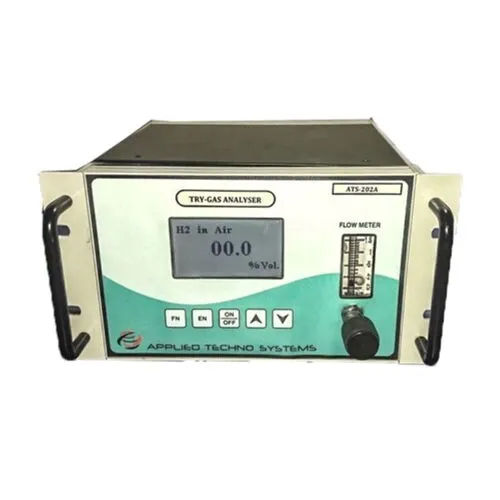- Dew Point Meters
- Gas Analysers
- Portable Gas Detector
- Moisture And Dew Point Analyzer
- Dust Monitor
- Gas Monitoring Systems
- Gas Leak Detectors
- Gas Transmitters
- VOC Leak Detector
- Air Quality Monitoring System
- Online Continuous Emission Monitoring System-OCEMS
- Dew Point Monitors
- Gas Detector
- Opacity Monitor
- Portable Flue Gas Analyzer
- Online SOX & NOX Gas Analyzer
- Methane Gas Leak Detector
- Hydrogen Purity Analyzer
- Gas Purity Analyzer
- Effluent Monitoring Systems
- Producer Gas Analyzer
- Gas Detector Calibration Service
- Portable Gas Monitors
- Gas Sensor Transmitter
Flue Gas Analyzers
Product Details:
Flue Gas Analyzers Price And Quantity
- 1 Unit
- 158000 INR/Unit
Flue Gas Analyzers Trade Information
- Cash Advance (CA) Cash in Advance (CID)
- 10 Unit Per Week
- 3 Days
- Asia Australia Central America North America South America Eastern Europe Western Europe Middle East Africa
- All India South India Central India West India North India East India Gujarat Karnataka Kerala Lakshadweep Mizoram Meghalaya Manipur Andhra Pradesh Bihar Chandigarh Daman and Diu Goa Jharkhand Odisha Punjab Assam Delhi Dadra and Nagar Haveli Andaman and Nicobar Islands Arunachal Pradesh Chhattisgarh Haryana Himachal Pradesh Jammu and Kashmir Madhya Pradesh Maharashtra Nagaland Rajasthan Sikkim Tamil Nadu Telangana Tripura Pondicherry Uttar Pradesh Uttarakhand West Bengal
Product Description
A flue gas analyzer is a device used to measure the composition of gases emitted from the combustion of fuels in boilers, furnaces, or engines. It is essential in monitoring exhaust gases like carbon monoxide (CO), carbon dioxide (CO2), oxygen (O2), nitrogen oxides (NOx), sulfur dioxide (SO2), and other pollutants to optimize combustion efficiency and ensure compliance with environmental regulations.
The analyzer typically uses a variety of sensors (such as electrochemical, infrared, or chemical sensors) to detect and measure the concentration of gases. Flue gas analyzers are often used in industrial settings, power plants, refineries, and HVAC systems. They help detect issues like incomplete combustion or excessive pollution and aid in maintaining safe operating conditions.
Key Features:
- Multi-gas detection: Measures gases like CO, CO2, O2, NOx, SO2, etc.
- Efficiency monitoring: Helps improve fuel usage and minimize emissions.
- Emission control: Ensures compliance with environmental standards.
- Portable and stationary models: Handheld devices for field use and fixed models for continuous monitoring.
- Data recording: Many models allow for data logging and reporting.
Frequently Asked Questions (FAQs)
-
What is a flue gas analyzer used for?
- A flue gas analyzer is used to measure the concentration of gases in the exhaust emissions of combustion systems, such as furnaces, boilers, and engines. It helps ensure optimal combustion efficiency, lower emissions, and compliance with environmental regulations.
-
Which gases are measured by a flue gas analyzer?
- Commonly measured gases include oxygen (O2), carbon dioxide (CO2), carbon monoxide (CO), nitrogen oxides (NOx), sulfur dioxide (SO2), and sometimes hydrocarbons (HC) and particulate matter.
-
How does a flue gas analyzer work?
- The analyzer uses sensors to detect and measure the concentrations of different gases in the exhaust flue. For example, electrochemical sensors measure O2, while infrared sensors are used for CO and CO2. These readings help operators adjust fuel and air mixtures to optimize combustion.
-
Why is measuring flue gases important?
- Measuring flue gases is critical to ensure the combustion process is running efficiently. It helps reduce fuel consumption, lowers harmful emissions, and ensures compliance with environmental regulations. Monitoring these gases also improves the safety and longevity of combustion systems.
-
How often should a flue gas analyzer be calibrated?
- Calibration should be done at least annually, but more frequent calibration may be needed in high-use or harsh conditions to ensure accurate readings. Some analyzers have auto-calibration features to enhance accuracy.
-
What industries use flue gas analyzers?
- Flue gas analyzers are used across various industries, including power generation, oil and gas, petrochemical, steel manufacturing, HVAC, and automotive industries, where combustion efficiency and emission control are critical.
-
Can a flue gas analyzer detect gas leaks?
- While primarily used to measure exhaust gases, some models can detect gas leaks, especially for flammable or toxic gases like methane (CH4) or carbon monoxide (CO). However, dedicated gas leak detectors are more suitable for that purpose.
-
What is the difference between a flue gas analyzer and a combustion gas analyzer?
- A flue gas analyzer measures the gases in the exhaust or flue of combustion systems to monitor emissions. A combustion gas analyzer is typically used to measure gases inside the combustion chamber itself to optimize the combustion process. Both analyzers share overlapping functions, but flue gas analyzers focus more on post-combustion emissions.
-
How long do the sensors in a flue gas analyzer last?
- Sensor lifespan varies by type and usage but generally ranges from 1 to 3 years. Electrochemical sensors typically need to be replaced more frequently, while infrared sensors last longer.
-
How can I maintain my flue gas analyzer?
- Regular calibration, sensor replacement, and following the manufacturer's maintenance guidelines are essential for ensuring accurate measurements and extending the life of the analyzer. Proper storage and handling of the device also help prevent sensor damage







 English
English Spanish
Spanish French
French German
German Italian
Italian Chinese (Simplified)
Chinese (Simplified) Japanese
Japanese Korean
Korean Arabic
Arabic Portuguese
Portuguese